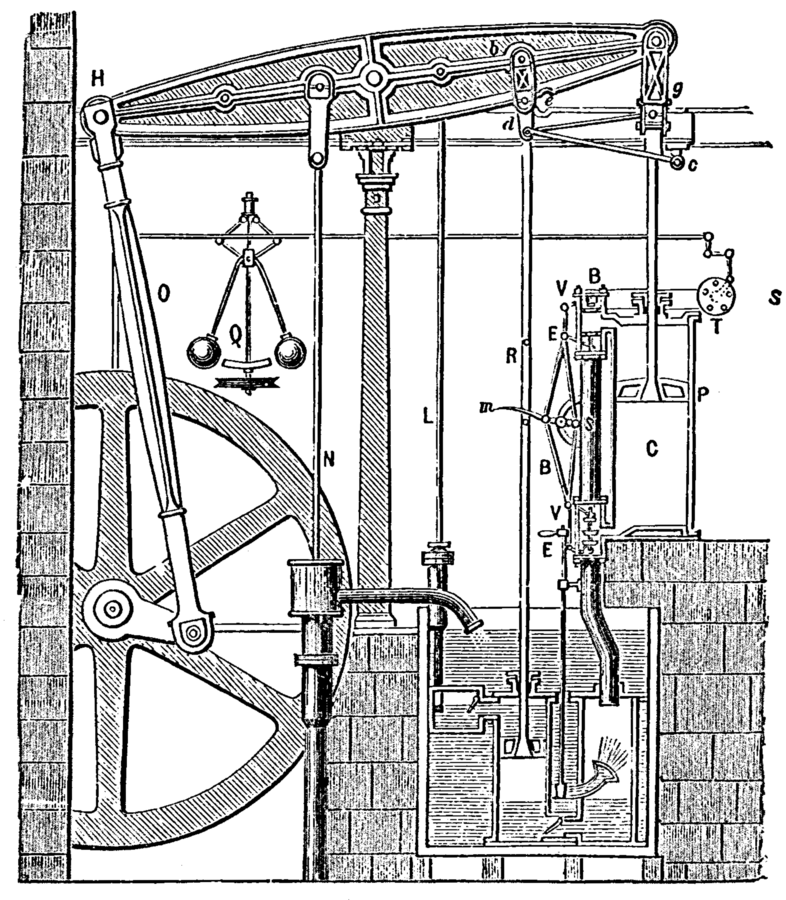James Watt was born on January 30, 1736, and he always had an interest in creating and innovating new things. At the age of seventeen years old, Watt had decided what he wanted to do with his life. He wanted to become a mathematical instrument maker.1 To make that happen, Watt needed to travel to Glasgow where he would fulfill his goal. Watt traveled to Glasgow, where he then worked at the University of Glasgow as a mathematical instrument maker. Later in life, in the year 1755, he traveled to London where he met his master to train him in mathematical practices, design, and building. It wasn’t until 1765 that he began one of his most successful accomplishments in his life: creating the most efficient steam engine anybody had ever seen.

One afternoon in the year 1764, Watt had been repairing a model of the Newcomen steam engine originally made by Thomas Newcomen in the year 1712. He had been given this model by an organization that used these steam engines to pump water out of coal mines to make it easier to mine. At the time, steam engines were one of the most powerful pieces of machinery used in the mines. The steam engine was used to provide mechanical power by using steam created by the engine. Workers would fill up a boiler with water, and a fire would then heat the boiler making steam. The steam would be transferred from the boiler to the cylinder through a pipe causing a piston to move up and down creating energy. This energy was spread throughout the mining sites to power other equipment and mainly pump water. Watt had finished repairing the steam engine and decided to put it to the test. While testing his newly repaired steam engine, Watt realized that more than a quarter of the steam created by the engine was being released and wasted, causing it to be inefficient when used in the work field. Watt knew his desire to innovate would lead him to improve this steam engine. Watt then spent the next year on the problem causing the loss of steam while using the engine. After that year’s long work, Watt realized that the problem of the steam engine was the loss of latent heat. Realizing this, Watt remembered the many different scientists he met, one being Joseph Black. Black was a British chemist and physicist who was the first to develop the concept of latent heat. Watt had first learned about this concept from Joseph Black himself while working at the University of Glasgow. It wasn’t until May of 1765 that Watt finally figured out a solution. Watt realized that he could utilize one of his great inventions known as a separate condenser.2 The separate condenser was made by Watt in 1765, just in time to use on the steam engine he had been trying to improve. The separate condenser was essentially a condensation chamber where the steam was transferred to. With the condenser and the working cylinder being separate, the condensation occurred without a significant loss of heat from the cylinder, ultimately preventing the loss of large amounts of steam. Watt had figured out a solution, but there was still an issue on how Watt would apply the separate condenser to the steam engine. Once he had figured this out, another old friend he had met, John Roebuck, had pushed him to make a small test engine. With loans from Joseph Black, Watt made a test engine. Within a couple of months, Watt transferred what he had done to the small prototype engine to the real steam engine. Even though Watt had fixed the initial issue, he was nowhere near done. He continued to improve the design of the engine by adding rotary motion. In doing this, it would eventually broaden the uses of the steam engine. Watt wanted to continue improving his design but had multiple financial setbacks while trying to do so.3

Watt’s innovation wasn’t too well known until he met industrialist Matthew Boulton. It was 1768 when Boulton came to Watt because he needed something to power his factory, specifically Watt’s improved steam engine. Watt agreed, knowing Boulton’s financial state, and over time they became friends and a team. With Boulton’s financial contributions, Watt improved his steam engine. With the help of Boulton, he was able to create a steam engine with two separate condensers making it extremely efficient for its time. In time, Watt and Boulton continued to work together. Soon Boulton had gained a share of Watt’s patent on the steam engine.4 This ultimately led to Watt and Boulton’s relocation to the United Kingdom, specifically to Birmingham. Watt and Boulton founded their new company known as Boulton and Watt in the year 1775. This was an early British engineering and manufacturing firm mainly in the business of designing stationary steam engines.5 With the start of this company, it had become a major driving force for the industrial revolution.6 Over time, steam engines were being produced, and they were becoming easier to obtain by companies. Soon, multiple companies had gotten their hands on the improved steam engine and were eager to test it. Once the steam engine was known as a successful piece of equipment to power other machinery, factories all around soon invested in them and started using them in their factories. With the steam engine being so efficient, companies started to invest because it made the production of manufactured goods quicker and more efficient. With that, more and more companies started to rise and run with the new industrialized businesses. With the steam engine being so successful more companies and factories started to emerge, leading to more industrial plants producing goods. Once these factories started to emerge, the industrial revolution had taken off. All over England, factories used the steam engine to power machines, such as the spinning mule and the power loom.7

Boulton and Watt successfully ran for over one hundred years. After Watt and Boulton’s passing, the company was successfully run by both of their sons. Eventually, in 1895, Bolton and Watt was forced to shut down as it could not be run anymore. Watt’s contributions to the industrial revolution in the form of the steam engine will never go unnoticed. With the help of multiple inventors, Watt created the most successful and efficient steam engine of its time. Watt’s steam engine played a key role in the development of the modern world and may go down as one of the most significant technological artifacts to ever be made.
- Andrew Carnegie, James Watt (Auckland: The Floating Press, 2009), 14. ↵
- K.V. Gopalakrishnan, “James Watt: Father of steam power,” Resonance: Journal of Science Education 14, no. 6(2009): 522-529. ↵
- Peter M. Jones, “Living The Enlightenment and the French Revolution: James Watt, Matthew Boulton, and their sons”, The Historical Journal 42, no. 1(1999): 157. ↵
- Brian Spear, “James Watt: The steam engine and the commercialization of patents, in New England Patent Information 30, no. 1(2008): 53-58. ↵
- Edward Elgar, Stage one:The Industrial Revolution in Britain (Edward Elgar Publishing, 2018), 358. ↵
- Eric Roll, “James Watt and the Industrial Revolution, The Journal of Economic History 6, no. 2 (1946): 225. ↵
- Ben Russell, “Preserving the Dust: The Role of Machines in Commemorating the Industrial Revolution”, History and Memory 26, no. 2(2014): 106-132. ↵



19 comments
Kacey Diaz
This article was interesting to read a I feel like I learned a lot about steam engines and how they work. In high school I learned about the Industrial Revolution but I don’t recall learning about this and how this started the revolution. I think it’s really cool that this idea led to a world changing revolution and its amazing that they were able too keep the company alive for more than 100 years.
Francisco Cruzado
I had never heard about Watt’s crucial improvement of the steam engine. It sounds like he was an amazingly creative man, willing to discover and question, to create and contradict. His life seems happy and exciting, and he also seems very focused in studying. I would have liked to have more details on the financial problems Watt faced, I felt somewhat disconnected from the character.
Sofia Almanzan
This was the most informative article I have read so far. I knew nothing about the history of the steam engine or how important it was in history. It was sad that their sons weren’t able to keep the business running but the advances in technology that this business created changed history.
Matthew Avila
It’s cool to read about how Watt built and perfected his steam engine. The engine was very important during the late 18th century and the main power source for factories. I remember trying to build a small steam engine for my physics class in high school to show the transfer of energy. it didn’t work but it was cool to see how the engine itself was supposed to function.
Berenice Alvarado
This article is interesting because it shows that when people work together they can achieve their goals and even make the world a better place. I also believe that the steam engine wouldn’t have been known as much as it is now if it wasn’t because of James Watt’s idea of making changes to the first steam engine making the new one better and more useful. It is sad that the company was still running and then was later shut down but the legacy that these two men, James Watt and Mathew Boulton, left behind will always be remembered.
Aiden Dingle
I think that it’s amazing how much Watt’s improvement affected the entire world. When he made the steam engine more efficient, it became a viable option for more businesses to improve their production through the use of machinery. Without Watt, the industrial revolution probably would’ve never happened just because the machines would have been to inefficient. It’s also amazing how long their business lasted. I thought that after they released the improved steam engine and sold them that they would go out of business relatively quickly, especially towards the late 1800s with the emergence of gasoline engines.
Seth Roen
I think it is net how steam power would have never been in such extensive uses if it wasn’t for James Watt. Honestly, it is incredible how some of these very complicated problems only need a relatively simple answer. I never know that James not only had modernized the steam engine and also had a business, I sad knowing that it went out of business.
Glory Turnbull
The steam engine is so essential to British culture! In my time in England, I visited the National Rail Museum, and I saw a model of Watt’s steam engine. J.M.W. Turner paints the ways in which he sees the industrial revolution changing the world around him, often using the steam engine as a motif in his paintings. Learning about Watt’s process has been fascinating, and I’m glad I encountered this article.
Raul Colunga
It was great learning about the history of James Watts and his contribution to advancing not just England but the world’s technology and bringing about the age of industrialization. It was impressive to see that his company lasted for 100 years and that his son along with Boulton’s son had kept the company alive until they sadly had to close down.